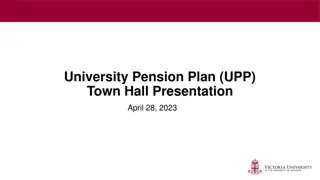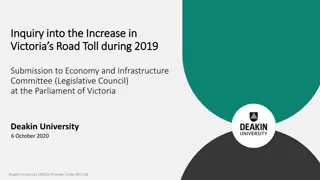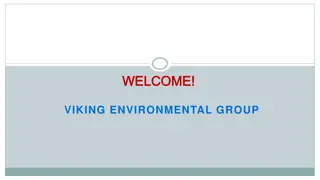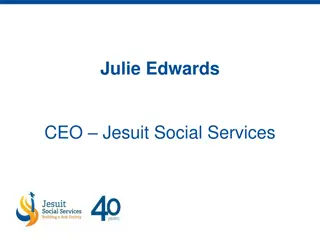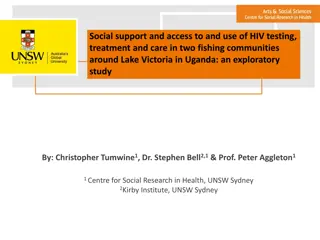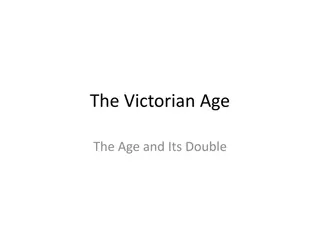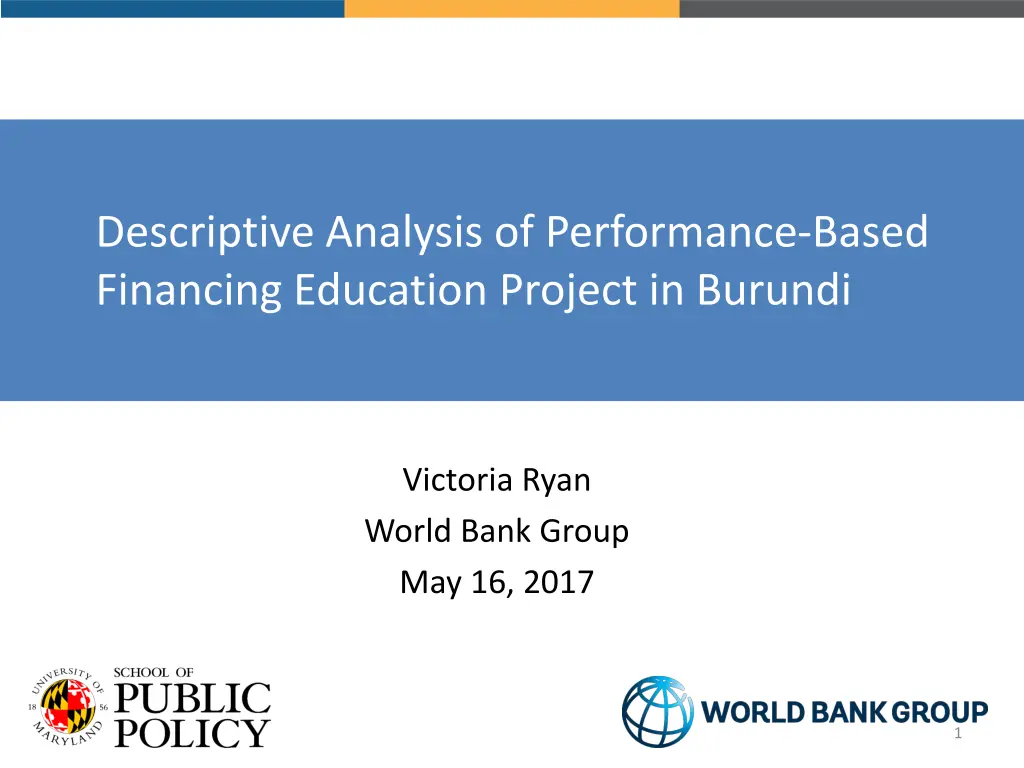
Performance-Based Financing in Burundi: Education and Health Projects Analysis
Explore the successful implementation of Performance-Based Financing (PBF) projects in education and health sectors in Burundi. Learn how PBF enhances service provider performance and quality through results-based financing strategies. Discover the impact on education access and healthcare outcomes in the region.
Download Presentation

Please find below an Image/Link to download the presentation.
The content on the website is provided AS IS for your information and personal use only. It may not be sold, licensed, or shared on other websites without obtaining consent from the author. If you encounter any issues during the download, it is possible that the publisher has removed the file from their server.
You are allowed to download the files provided on this website for personal or commercial use, subject to the condition that they are used lawfully. All files are the property of their respective owners.
The content on the website is provided AS IS for your information and personal use only. It may not be sold, licensed, or shared on other websites without obtaining consent from the author.
E N D
Presentation Transcript
Descriptive Analysis of Performance-Based Financing Education Project in Burundi Victoria Ryan World Bank Group May 16, 2017 1
Introduction of PBF Pilot Project in Bubanza Issue Area: Education & System Strengthening Project duration (2014-16): 2 years Target Population: 6,536 students Mission:To provide greater access to quality education for all children by improving quality of teaching and learning. 2
PBF Health Project in Burundi Issue Area: Health & System Strengthening Program duration (2006-17): 11 years Target Population: 735 health centers Mission:To provide greater access to healthcare by improving quality of service provision. Improved healthcare outcomes: pre-natal care, assisted deliveries & vaccinations. 3
What is Performance Based Financing? Strategy of financing based on results. Mechanism whereby the payment of funds is conditional on the achievement of pre-defined objectives. Improves service provider performance and services through financial motivation. Output-focused - Funds given after services provided Emphasis on staff motivation & autonomy Performance- based financing Strict Empowerment of stakeholders monitoring mechanism Obligation for performance 4
Traditional vs. Results-based approach* Performance Based Financing Traditional Financing 3 1 2 $ $ For the service providers: Autonomy of management Assurance of quality Motivation of staff Inputs to service providers Outputs of service providers 1 Financing given based on results achieved (and not on perceived input needs) 2 Funds directly transferred to service providers, not used to provide inputs "in kind" 3 Designed to address internal problems of the service providers *World Bank Group PBF and free healthcare in Burundi presentation
Research Methodology Research project: Goal: Implementation evaluation of performance-based financing pilot project Draw conclusions about strength of design and implementation to inform feasibility of scale-up Methodology: Conducted interviews with key stakeholders, analyzed administrative data, conducted research 6
Key Characteristics to PBF success There are six key cross- cutting characteristics that are indicative of success in a PBF program, regardless of the sector. Government buy-in M&E System Transparency Role definition, separation & decentralization Establishment of Contracts Autonomy 7
Establishment of contracts Program Design Strengths Challenges 1. Contracts clarify roles and responsibilities 2. Set objectives, identify problems and outline strategies 3. Organizational capacity of all actors strengthened & more collaborative culture 1. Short-term thinking 2. Contracts & action plans served to improve understanding, but not always successful in practice 3. Disconnect in communication observed 1. Establishment of contracts 2. Action plans developed by schools and regulatory agencies 3. Schools & regulatory agencies developed goals to achieve 8
Definition, separation and decentralization of roles Program Design Strengths Challenges 1. School management committees 2. Continuous monitoring of schools by regulators 3. Funds disbursed to school only after verifying spending 1. Increased community participation 2. Removed threat of gaming the system 3. Strong structure of checks and balances 1. Ensuring engagement 2. Time consuming activity 3. Payment process very delayed (up to 3 months) 9
Autonomy Program Design Strengths Challenges 1. Empowerment and autonomy of stakeholders 2. Spending on locally- identified needs 3. Motivated actors to produce quality outputs 4. Puts actors on level playing field 1. Actors given decision- making power 2. Schools spent funds autonomously 3. Quality Scores 4. Equity funding mechanisms 1. Perceived as more work instead of better work 2. Demanding monitoring system 3. N/A 4. Extreme resource constraints faced by schools 10
Transparency Program Design Strengths Challenges 1. Payment report submitted of services provided by school 2. Bonuses given to schools who exceeded targets 3. Intrinsic and extrinsic motivation for teachers 1. Open exchange of information 2. Motivates schools to perform well 3. Teachers motivation improved 1. Reporting process very time consuming 2. Infrastructure/unfair geographic challenges 3. Impact of intrinsic and extrinsic motivation 11
Government buy-in Program Design Strengths Challenges 1. Government entities feel engaged and invested in PBF success 2. Open communication between community & government 3. Government sees benefits of PBF; put forth financing 1. Ministry of Education at central and decentralized levels have different responsibilities 2. Provincial level plays regulating role 3. Provincial regulators ensure PBF accounts for national strategy 1. Engaged at expense of PBF effectiveness 2. Weak M&E system and ability to monitor program 3. Costly program; in conjunction with health, question sustainability 12
Monitoring & Evaluation System Program Design Strengths Challenges 1. Positive behavior change observed 2. Multiple layers of data verification 3. Increased accountability 1. Time consuming 2. Conflict of interest in data verification 3. ADIS has too much responsibility 1. Qualitative & quantitative indicators 2. Data verification 3. Data validation 13
Key characteristics & PBF Education Project PBF Ed Score Best Practice Recommendations Introduce satisfaction surveys to measure opinions and make management decisions High High Put in place more long-term plans Decentralize payments, create secondary contracts Medium Remove conflict of interest (DCE/ICE verification), reevaluate bonus structure Medium Set up national technical management unit to ensure government regulation of M&E system and develop public-private partnership at the provincial-level Medium Separate verification and validation roles (ADIS); ADIS should not play permanent role; revamp M&E tools; ensure monthly data collection and analysis; use monthly data for school performance verification; conduct refresher trainings Low 14
Conclusion Impressive results in health Leverage lessons learned & health organizational structures Implementation consistent with key characteristics Identify risks and put in place appropriate mechanisms Main concerns: sustainability, cost efficiency, capacity of education system To mitigate concerns, build capacity of stakeholders & do continuous monitoring and design assessment 15
Questions? 16

